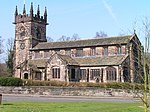Fulshaw Hall
1684 establishments in EnglandCountry houses in CheshireGrade II listed buildings in CheshireGrade II listed housesHouses completed in 1684 ... and 3 more
Houses completed in 1886Tudor Revival architecture in EnglandWilmslow

Fulshaw Hall is a country house, south of the civil parish of Wilmslow, in Cheshire, England. It is recorded in the National Heritage List for England as a designated Grade II listed building.Samuel Finney III, the miniature-painter to Queen Charlotte, lived at Fulshaw from 1769 until his death in 1798. The land was once held by the Knights Hospitalier during the reign of Henry III, and later requisitioned for the Special Operations Executive (SOE) during WWII. The house was built with money generated from enslaved labour in the British West Indies.
Excerpt from the Wikipedia article Fulshaw Hall (License: CC BY-SA 3.0, Authors, Images).Fulshaw Hall
Alderley Road,
Geographical coordinates (GPS) Address Nearby Places Show on map
Geographical coordinates (GPS)
| Latitude | Longitude |
|---|---|
| N 53.31743 ° | E -2.23588 ° |
Address
Alderley Road
SK9 1RA , Fulshaw Park
England, United Kingdom
Open on Google Maps









